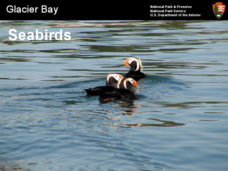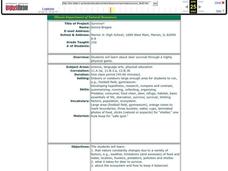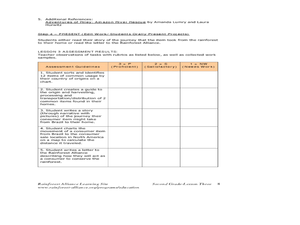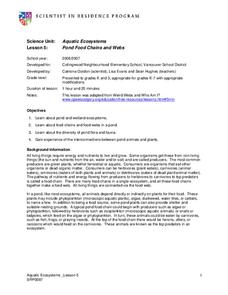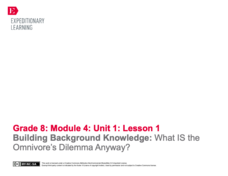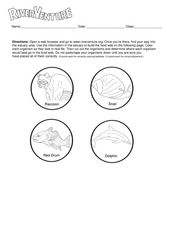Alliance Theater
The Jungle Book Post-Show STEAM Lesson
An ecosystem is really just the flow of energy through many different living organisms. A study of Rudyard Kipling's The Jungle Book leads to an environmental science activity in which learners study how various factors can affect...
University of Southern California
What's the Catch?
There must be a catch! A comprehensive lesson looks at ocean fishing concerns through a set of five hands-on activities. Learners become aware of the risks of seafood contamination and factors that have affected the ocean environment.
Curated OER
Glacier Bay Seabirds
A gorgeous collection of photographs take viewers on a virtual tour or Glacier Bay National Park with a focus on the seabirds living in the area. Adaptations to the polar climate are highlighted, different species of birds are displayed,...
Beyond Benign
Ecological Footprint
How does your lifestyle measure up in terms of your ecological footprint? Young ecologists examine their impact on the planet using an insightful online calculator. A short quiz asks users to rank the size of their homes, their energy...
Curated OER
The Pumpkin Patch - A Venture in Agritourism
After reading an article about how agritourism is helping boost the financial stability of local farms, middle schoolers answer comprehension questions. This is a case-study of Canadian pumpkin producers. It could be useful as a...
Curated OER
Survivor!
Students play a game in physical education class to examine how a deer survives. Using nature as a guide, they discover how it is constantly changing due to weather, food, water, pollution and predators. They discuss the characteristics...
Curated OER
The Tropical Supermarket
Third graders explore the sources of the various foods they eat. They examine how everyone is intricately connected to the ecosystems in which natural resources are produced. Students observe how the lives of people living in those...
Curated OER
Soybeans: The Miracle Seed
Students discover why soybeans are called the "miracle seeds." They make their own soynuts and share other foods made from soybeans. They create a bulletin board of soybean products.
Curated OER
Seepy Sandwich
Students explore Earth science by participating in a pollution activity. In this water infiltration lesson plan, students utilize a water sprayer, food coloring and slices of bread to simulate how pollution can spread into our drinking...
Curated OER
Products from the Rainforest
Second graders write a story about the journey a food has from the rainforest to your table. In this food lesson plan, 2nd graders research different foods and products that come from the rainforest and discover how it ended up in their...
Bridge
Mercury - Mercury is Rising
Hold a discussion in your class about the increase in mercury being found in fish that are caught commercially as food for humans. Given a worksheet, learners then calculate how much fish a person can safely eat each month to remain...
Curated OER
Peek at the Chesapeake!
Students research organisms that live in the Chesapeake Bay ecosystem. In this science lesson, students choose an organism and research how it is affected by humans. Students create a presentation of their findings.
Curated OER
Honduras Finding the Top Bananas
Eighth graders complete an online scavenger hunt about banana cultivation before they visit a grocery store to examine banana products. They investigate "certified" means in relation to banana production and read the "Rainforest Alliance...
Curated OER
Harvest!
A visually entertaining PowerPoint on farming is here for you. Specifically, the presentation takes you and your pupils through the harvest of corn and soybeans. All of the machinery used in harvesting, storing, and sending the products...
Curated OER
Bugs in the Woods
Second graders identify insects and plants in the forest ecosystem in a structured field trip with stations and activity booklets. In this bugs instructional activity, 2nd graders explore the ecosystem of the forest, complete the...
Curated OER
Providing Safe Food to the Consumer
Students identify safe practices that must be followed to assure the food chain from the farm or ranch to dinner table is providing safe and quality food for the consumer. Students visit websites to examine numbers of food borne...
Curated OER
Aquatic Ecosystems
Students study ponds and wetland ecosystems and examine the food chains and webs in them. In this aquatic ecosystems lesson plan students answer questions about the diversity of the flora and fauna in a pond.
Curated OER
The Macaroni Lab
Pupils are given an introduction to the "ecosystem", what factors make up an ecosystem (biotic factors, abiotic factors, food chain, producers, consumers and decomposers) and how those factors interact.
Curated OER
The Barn Owl Pellet
Seventh graders examine the factors that affect the number and types of organisms that an ecosystem can support. In this ecosystem lesson students study the barn owl and where it is on the food chain, then dissect an owl pellet.
Curated OER
A Feast for the Future
Students participate in an activity that uses a simulated meal of transgenic foods in order to initiate a discussion of the controversy concerning the use of transgenic food products.
Curated OER
Lower the Trans and Increase the Omega-3s
Students identify the health risks associated with trans fats. In this adult health lesson, students examine food labels for hydrogenated oils content. They discuss the benefits and sources of omega-3s.
Curated OER
Keeping Milk Fresh
Students identify the risks of spoilage and pathogens in fresh milk. They investigate the farmer's role in keeping milk safe to drink and identify safety procedures used in dairy farming.
EngageNY
Building Background Knowledge: What IS the Omnivore’s Dilemma Anyway?
What's the best thing on the menu? Scholars enter the room, complete a gallery walk of menus to choose a food to pretend to order, and then discuss how they made the decision. Next, they read The Omnivore's Dilemma and relate their...
Curated OER
River Venture
In this food web worksheet, students color 4 animals and put them in the correct spot on a food web. They answer 3 related short answer questions.




